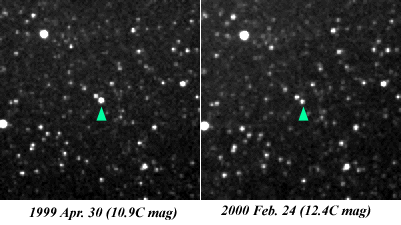Home Page Updated on March 31, 2003
Recovery of NSV 24062March 29, 2000Yoshida, S.; Kadota, K.; Kato, T.; Yamaoka, H. Seiichi Yoshida and KenIchi Kadota recovered a possible symbiotic star discovered by Yukio Sakurai in 1994 (cf. IAUC 6051), NSV 24062. Here is the report. Everything is made clear by public discussion on the VSOLJ (Variable Star Observers' League in Japan) mailing list. Thanks so much for the contributors. In the course of variable star survey based on the MISAO Project observations, Seiichi Yoshida discovered a variable star at R.A. 17h59m39s.58, Decl. -25o13'30".0 (2000.0) with a range of 10.8 - 12.4 mag from unfiltered CCD variable star survey images taken by Kadota between 1999 April and 2000 February, being supported by the semi-automated variable star detection by a software, the PIXY system. Here is the photometry:
The position and magnitude are measured with USNO-A1.0 catalog. The position end figures by Kadota using 12 stars in the GSC-ACT is 39s.58, 29".1. Taichi Kato pointed out that this object is probably identified with NSV 24062, a possible symbiotic star discovered by Yukio Sakurai in 1994 (cf. IAUC 6051). The position of NSV 24062 is R.A. 17h56m35s.54, Decl. -25o13'15".7 (1950.0), R.A. 17h59m40s.6, Decl. -25o13'24" (2000.0). Kato also pointed out that no observations have been reported since 1994 August. The angular distance between these two stars is 15 arcsec. Therefore, we must have recovered the outburst of this star. And the position in IAUC 6051 is probably inaccurate. Here is the magnitude reported in IAUC 6051.
There is no data recorded in the IRAS Point Source Catalog, therefore it must be faint in IR-band in 1983. At the position of the star discovered in the MISAO Project, there is a bright star USNO-A2.0 0600.29859229, however, no data is recorded in the USNO-A1.0 catalog. USNO-A2.0 0600.29859229 17 59 39.613 -25 13 30.30 12.1R 14.2B Hitoshi Yamaoka investigated the DSS-1 and the DSS-2 images and found this star on them. On the DSS-1 blue UK Schmidt plate taken on Sept. 15, 1987, it was as bright as USNO-A1.0 0600.14859958, 15.2 mag(R), 16.8 mag(B). On the DSS-2 red UK Schmidt plate taken on Sept. 7, 1991, it was very bright, brighter than USNO-A1.0 0600.14861605, 11.7 mag(R), 15.0 mag(B), as bright as (or a bit brighter than) USNO-A1.0 0600.14850922, 11.2 mag(R), 11.8 mag(B), and a bit fainter than USNO-A1.0 0600.14874588, 10.9 mag(R), 12.2 mag(B). At the position of NSV 24062 described in IAUC 6051, there is no data recorded in the USNO-A1.0 and USNO-A2.0 catalogs, and no star was found on the DSS-1 and the DSS-2 images. But 10 arcsec from the position, there is a star USNO-A1.0 0600.14859811, 13.3 mag(R), 15.0 mag(B) = USNO-A2.0 0600.29861167, 12.5 mag(R), 15.3 mag(B), which was detected on Kadota's images just besides NSV 24062. It was about 12.3C mag on all images. No variability was confirmed. The finding chart of this star based on the Kadota's images: 
References (Supplement on March 30, 2003) NSV 24062 was registered as V4683 Sgr based on this research in: IBVS 5135 The GCVS record says it is a Mira type variable with a range of 10.8 - 19 mag. The maximum is based on the unfiltered CCD observations by the MISAO Project. The minimum is based on the brightness in 1950 reported in IAUC 6051. However, the observation in 1950 as 19 mag(B) is probably the measurement of a wrong star. Investigating the Palomar plate image at: USNO Flagstaff Station Finder Chart Service there is a faint star at the position reported in IAUC 6051, which is much fainter than USNO-A2.0 0600.29857911, R.A. 17h59m38s.751, Decl. -25o13'35".22 (2000.0), 17.4 mag(R), 19.5 mag(B). The observation in 1950 as 19 mag(B) is probably the measurement of this star. NSV 24062 = V4683 Sgr is visible as bright as USNO-A2.0 0600.29861509, R.A. 17h59m41s.141, Decl. -25o13'36".76 (2000.0), 15.2 mag(R), 16.3 mag(B), so roughly around 15 mag(B). The observation in 1976 as 14-15 mag(B) is correct. Therefore, the brightness range of NSV 24062 = V4683 Sgr is much smaller than recorded in the GCVS. The minimum is probably around 15 mag(B).
References (Supplement on March 31, 2003) Brian Skiff reported in [vsnet-chat 6187]: Along with the correction noted by Yoshida-san, I note that both the USNO-x.x and GSC-2.2 coordinates seem to be affected by crowding. The current 'best' position is probably from UCAC1, which agrees within 0".05 with that from 2MASS: 17 59 39.575 -25 13 28.70 (J2000, UCAC1) Indeed the UCAC1 proper motion is probably spurious due to the poor USNO-A2.0 position. The star is quite red, with 2MASS J-K = 1.7, and there is a good MSX detection (MSX5C G004.7856-00.8008).
References |
